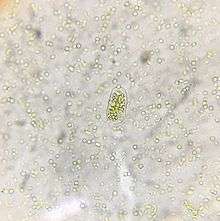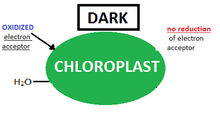Hill reaction
The Hill reaction was discovered by the biochemist Robin Hill from the University of Cambridge in 1937. The Hill reaction is the light-driven transfer of electrons from water to Hill reagents (non-physiological oxidants) against a chemical potential gradient. The Hill reaction demonstrated that oxygen O2 is produced in plants in a process that is separate from the process that converts carbon dioxide (CO2) to sugars. Hill's observation made a basic underlying refinement to our modern understandings of the process of photosynthesis.
History
The evolution of oxygen during the light-dependent steps in photosynthesis (Hill reaction) was proposed and proven by the British biochemist Robin Hill. He demonstrated that isolated chloroplasts would make oxygen (O2) but not fix carbon dioxide (CO2). This is evidence that the light and dark reactions happen in different places within the cell.[1][2][3]
Attributions

Hill reaction of photosynthesis was discovered by Robin Hill (1937). He found that isolated chloroplasts from plants can release oxygen when they are illuminated by sunlight in the presence of a suitable electron acceptor such as ferricyanide. To demonstrate the Hill reaction in the laboratory dichlorophenolindophenol (DCPIP) was used as the terminal electron acceptor, replacing NADP which was not available due to the extraction of the chloroplasts from the plant cellular environment. The ferrocyanide is reduced (just as NADP is when the chloroplast is in vivo) while water (H2O) is oxidized into oxygen (O2) and hydrogen cations during the reaction. By using this technique to observe the reaction, Hill revealed a variety of valuable facts about photosynthesis. The Hill reaction confirms that oxygen (O2) is produced by a reaction that is separate from carbon dioxide (CO2) fixation. The reaction in which oxygen is released requires light; therefore the Hill reaction can be described as the light dependent reaction of photosynthesis. The reaction in which oxygen is released takes place within the chloroplast of plants and the Hill reaction demonstrated that the release of oxygen (O2) is only a partial reaction which requires one step of photosynthesis.

The Hill reaction implies that the light dependent reaction of photosynthesis is a result of a series of redox reactions and a suitable terminal electron acceptor is required for that reaction to occur. Plants have natural electron acceptors such as NADP, that play a major role in the oxidation of water. The Hill reaction also shows that the natural electron acceptors of the reaction can be substituted by an artificial electron acceptor such as DCPIP, again allowing for the discharge of oxygen. The technique of replacing the natural electron acceptors with artificial electron acceptors can be used in the laboratory to provide a means to measure phosphorylation in chloroplasts and observe its relation to the discharge of oxygen in this reaction.
Hill's finding was that the origin of oxygen in photosynthesis is water (H2O) not carbon dioxide (CO2) as previously believed. Hill's reaction also demonstrates that the light dependent redox reaction is the first reaction to take place in photosynthesis. The electrons thus freed by the splitting of water provides the electrons needed by the antenna system of photosystem II where they are boosted in energy and then sent along the electron transport system (ETS). Those high energy electrons are able to move against a chemical potential gradient. Hence, solar energy is converted to chemical energy by the reduction of NADP to NADPH.[4]
Biochemistry

Natural electron acceptor of photosynthesis
Photosynthesis is the process in which light energy is absorbed and converted to chemical energy. This chemical energy is eventually used in the conversion of carbon dioxide (CO2) to sugar (CH2O) in plants. During the process of photosynthesis, a natural electron acceptor, nicotinamide adenine dinucleotide phosphate (NADP), is reduced in chloroplasts to NADPH.[5] Overall within a chloroplast, the following equilibrium reaction takes place.
A reduction reaction that stores energy as NADPH:
NADP+ + 2H+ + 2e− → NADPH + H+ (Reduction)
An oxidation reaction as NADPH's energy is used elsewhere:
NADP+ + 2H+ + 2e− ← NADPH + H+ (Oxidation)
Ferredoxin, also known as a NADH+ reductase, is an enzyme that catalyzes the reduction reaction. It is easy to oxidize NADPH but difficult to reduce NADP+, hence a catalyst is involved. Cytochromes are conjugate proteins that contain a haem group.[5] The iron atom from this haem group undergoes redox reactions:
Fe3+ + e− → Fe2+ (Reduction)
Fe3+ + e− ← Fe2+ (Oxidation)
Using chloroplasts in vitro


Robin Hill (1937) studied the redox reactions in photosynthesis using artificial electron acceptors. He studied the reaction with the absence of CO2 by placing isolated active chloroplasts under light and dark conditions. During his observations of isolated chloroplasts placed under light conditions but with the absence of CO2, the artificial electron acceptors were reduced and then oxidized, completing the cycle and allowing the process to proceed. Oxygen (O2) was released as a byproduct, but there was no production of a sugar (CH2O) under those conditions. On the other hand, during Hill's observation of chloroplasts placed under dark conditions and in the absence of CO2 the artificial electron acceptor was oxidized but not reduced, terminating the process, with the result that there was also no production of oxygen and sugar. This observation allowed Hill to conclude that oxygen is released during the light-dependent steps (Hill reaction) of photosynthesis.[6]


Further studies of the Hill reaction were made in 1957 by the American plant physiologist Daniel I. Arnon. Arnon studied the Hill reaction using a natural electron acceptor, NADP. This natural electron acceptor inhibits the formation of ATP, NADPH, and H+ which are used in the light independent reaction. He demonstrated that the isolated active chloroplasts which are subjected to light but without CO2 will release oxygen but no sugar will be produced. He then demonstrated the light independent reaction, observing the reaction under dark conditions with an abundance of carbon dioxide. He found carbon fixation was independent of the light reaction. Arnon had effectively separated the light dependent reaction, which produces ATP, NADPH, H+ and oxygen, from the light independent reaction, which produces sugars. He was able to conclude that that part of the reaction happens without the presence of light.
Relation to phosphorylation
The association of phosphorylation and the reduction of an electron acceptor such as ferricyanide increase similarly with the addition of phosphate, magnesium (Mg), and ADP. The existence of these three components is important for maximal reductive and phosphorylative activity. Similar increases in the rate of ferricyanide reduction can also be stimulated by a dilution technique. The dilution technique will not cause a further increase in the rate in which ferricyanide is reduced with the accumulation of ADP, phosphate, and Mg to a treated chloroplast suspension. ATP has been shown to inhibit the rate of ferricyanide reduction. By the studies of light intensities, it is concluded that the effect is largely on the light-independent steps of the Hill reaction. These observations are explained in terms of a proposed method in which phosphate esterfies during electron transport reactions, leading to the reduction of ferricyanide, and the rate of electron transport is limited by the rate of phosphorylation. If there is an increase in the rate of phosphorylation, then there will be an increase in the rate by which electrons are transported in the electron transport system.[7]
Hill reagent

It is possible to introduce into the light reaction an artificial electron acceptor, such as a dye that changes color when it is reduced. These are known as Hill reagents. The Hill reagent was discovered in 1937 by Robin Hill. These dyes permitted the finding of electron transport chains during photosynthesis. dichlorophenolindophenol (DCPIP), an example of these dyes, is widely used by experimenters. DCPIP is a dark blue solution that becomes lighter as it is reduced. It gives experimenters a simple visual test and observation of the light reaction.[8] In another approach to studying photosynthesis, light-absorbing pigments such as chlorophyll can be extracted from the chloroplasts of plant leaves or other photosynthetic living organisms. Like so many important biological systems in the cell, the photosynthetic system is ordered and compartmentalized in a system of membranes.[9]
See also
References
- ↑ Hill, R. (1937). "Oxygen Evolved by Isolated Chloroplasts". Nature. 139 (3525): 881. doi:10.1038/139881a0.
- ↑ Hill, R.; Scarisbrick, R. (1940). "Production of Oxygen by Illuminated Chloroplasts". Nature. 146 (3689): 61. doi:10.1038/146061a0.
- ↑ Hill, R. (1939). "Oxygen Produced by Isolated Chloroplasts". Proceedings of the Royal Society B: Biological Sciences. 127 (847): 192. doi:10.1098/rspb.1939.0017.
- ↑ Hall, David Oakley (1981). Photosynthesis (3rd ed.). University of London: Edward Arnold. pp. 14, 79, 84.
- 1 2 Barber, James (1976). The intact chloroplast (1st ed.). Imperial college of Science and Technology. p. 476.
- ↑ Dilley, Richard (1989). Photosynthesis molecular biology and biochemistry. Norosa. p. 441.
- ↑ Avron, M. "Photosynthetic Phosphorylation relation to the Hill reaction". Research Gate. Johns Hopkins University of.
- ↑ Stiban, Johnny (2015). Cell Biology lab manual (6th ed.). Birzeit University: Dr. Stiban.
- ↑ Pentz, Lundy (1989). The biolab book (2nd ed.). The Johns Hopkins University press: Lundy.